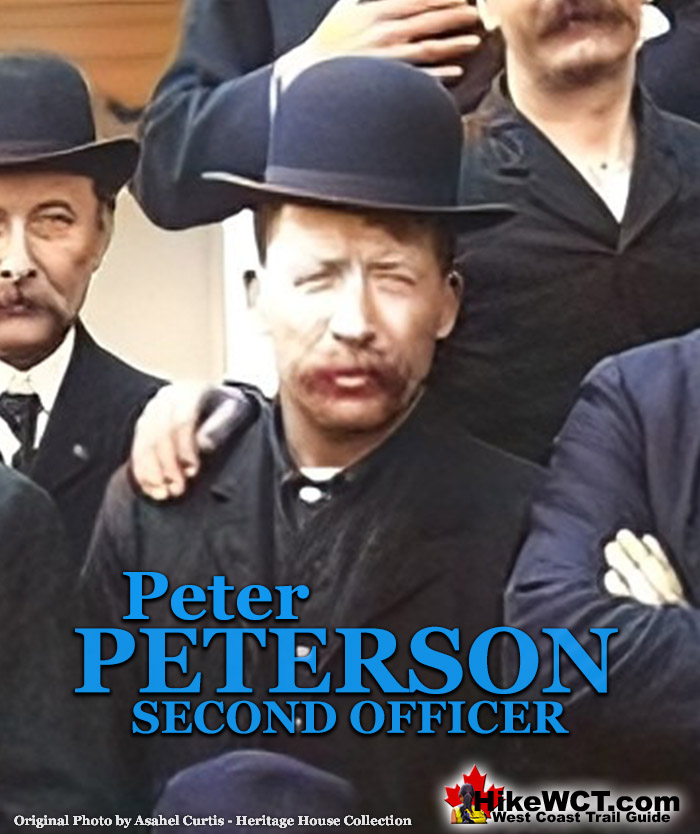![]() Peter Peterson was the second officer on the Valencia and one of the Topeka Raft survivors. He played a significant role in the events that unfolded during the 37-hour ordeal, which claimed an estimated 136 lives, leaving only 38 survivors. Peterson was an experienced sailor, having run the San Francisco to Seattle route over 100 times, including as second mate on the City of Puebla, the ship the Valencia was temporarily replacing.
Peter Peterson was the second officer on the Valencia and one of the Topeka Raft survivors. He played a significant role in the events that unfolded during the 37-hour ordeal, which claimed an estimated 136 lives, leaving only 38 survivors. Peterson was an experienced sailor, having run the San Francisco to Seattle route over 100 times, including as second mate on the City of Puebla, the ship the Valencia was temporarily replacing.
The Valencia Disaster
![]() 1. The Valencia
1. The Valencia ![]() 2. The Voyage
2. The Voyage ![]() 3. The Boats
3. The Boats ![]() 4. The McCarthy Boat
4. The McCarthy Boat ![]() 5. The Bunker Party
5. The Bunker Party ![]() 6. On the Valencia
6. On the Valencia ![]() 7. The Rafts
7. The Rafts ![]() 8. The Turret Raft
8. The Turret Raft ![]() 9. The Rescue Ships
9. The Rescue Ships ![]() 10. The Aftermath
10. The Aftermath ![]() 11. The Survivors
11. The Survivors ![]() 12. The Lost
12. The Lost
The West Coast Trail
![]() Prologue
Prologue ![]() 1: The West Coast Trail
1: The West Coast Trail ![]() 2: When to Hike & Fees
2: When to Hike & Fees ![]() 3: Trailheads
3: Trailheads ![]() 4: Getting There
4: Getting There ![]() 5: Considerations
5: Considerations ![]() 6: Campsites
6: Campsites ![]() 7: Shipwrecks
7: Shipwrecks ![]() 8: Routes
8: Routes ![]() 9: Sights & Highlights
9: Sights & Highlights
Peterson had previously sailed on the Pomona, where he lost a finger, indicating his long career at sea. On the night of the wreck, Peterson studied the Valencia’s log, an instrument used to estimate the ship’s speed, and calculated that the ship had travelled 307 miles beyond Cape Blanco, suggesting it was 13 miles from the Umatilla lightship. However, Captain Oscar Johnson and first officer William Holmes believed the log was overrunning by about 6%, meaning the ship was moving slower than indicated. This miscalculation, combined with poor visibility and stormy weather, led to the Valencia missing the entrance to Juan de Fuca Strait and striking a reef along Vancouver Island near Pachena Point.
When the Valencia struck the reef just before midnight on January 22, 1906. The ship was intentionally driven onto the reef to prevent immediate sinking, but it remained perilously close to shore—about 100 yards—trapped between sheer cliffs and pounding waves. In the ensuing panic, several lifeboats were launched against the captain’s orders, most of which capsized or were smashed against the rocks, killing many passengers, including all women and children aboard. Peterson witnessed the catastrophic failure of these attempts, with one lifeboat’s stern falling into the sea, spilling passengers into the surf.
By Wednesday morning, January 24, with the ship disintegrating, only two life rafts remained. Peterson was among the 19 men who boarded the second raft, later known as the "Topeka Raft," which was spotted by the steamship City of Topeka after two hours at sea. The raft was then boarded by anyone brave enough to leap from the ship into the churning ocean and climb aboard. Peterson later recalled:
“We had great difficulty in keeping the raft out of the whirlpool at the vessel’s side. The water was washing over the smokestack of the vessel, and at times the raft was tossed in the air. When the captain gave the word, I made a jump, and succeeded in grabbing a line to attach to the raft. I was already weak from hunger and exposure, and it was all that I could do to hold on. I finally succeeded in pulling myself aboard the raft.”
The survivors were in dire condition, with Peterson losing consciousness as they were finally pulled aboard at 1pm, suffering from cold and exhaustion. The raft was overcrowded with 19 men, highlighting the desperation of their escape. Peterson barely survived his three-hour exposure to the frigid conditions and a few more minutes on the raft would likely have been fatal. Peterson later credited Cornelius Allison for saving his life on the Topeka Raft by holding his head above water.
Peter Peterson’s name appears in survivor lists, though misspelled in some sources, such as Michael C. Neitzel’s book The Final Voyage of the Valencia, mistakenly spell it as "Petterson." Early newspaper reporting of the Dominion investigation often spell his name Pierre Petterson.
After recovering from the Valencia disaster, Peterson went back to sea. In an interview at the Rainier Grand hotel in Seattle, he described how he barely survived, but went on to say, “But I’m going back to the sea. I’ve been a sailor for thirty years and there is nothing else left for me to do.” The Pacific Merchant Marine publication shows he was first officer on the SS Breakwater of Portland until 1909, when he resigned, having a master’s position in view.

